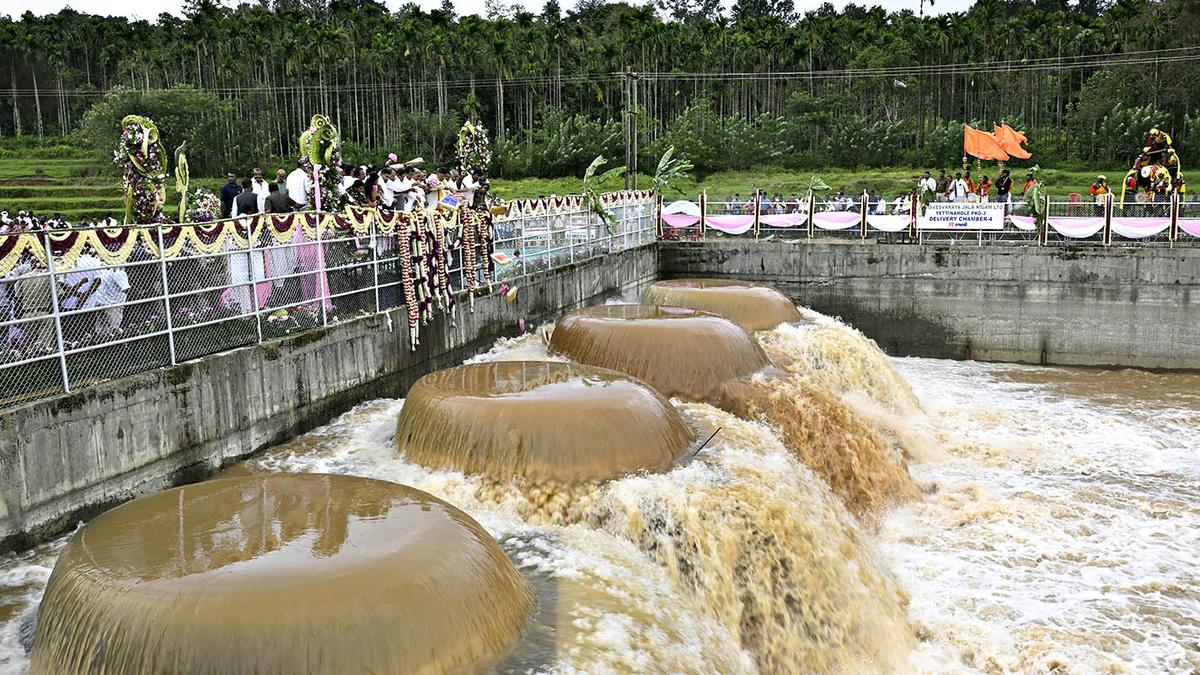Karnataka Chief Minister Siddaramaiah and Deputy Chief Minister D.K. Shivakumar and others inaugurate Stage 1 of Yettinahole Integrated Drinking Water Supply Project at Hebbanahalli in Sakaleshpura taluk of Hassan district on September 6, 2024.
| Photo Credit: The Hindu
The Congress government in Karnataka, which has been struggling to deal with controversies raised by the Opposition as well as its own internal squabbles over leadership, got a much-needed break from bad press when it inaugurated the ambitious Yettinahole Integrated Drinking Water Project last week. The project aims to harness 24.01 tmcft of water from the catchment area of the Nethravathi River, which originates in the Western Ghats and flows through the hilly Malnad districts and coastal area, to provide water to seven arid districts of southern Karnataka.
However, the project, which is being implemented at an estimated cost of ₹23,251 crore, has been controversial since its inception. It has its genesis in a report submitted by Dr. G.S. Paramashivaiah, who retired as Superintendent Engineer with the State government, on providing permanent irrigation facilities for arid districts by diverting excess water from west-flowing rivers. The Yettinahole project is part of what he had initially recommended in his report.
Paramashivaiah himself was unhappy with the way the project was being planned, arguing that it should be implemented in its entirety. The people of the Malnad and coastal regions too have been opposing the project, alleging that it would affect both the Western Ghats, a biodiversity hotspot, and the people who depend on the Nethravathi in the downstream. Despite these protests, in 2012, the Bharatiya Janata Party (BJP) government, led by D.V. Sadanada Gowda, gave administrative approval for the project.
Activists then moved the National Green Tribunal (NGT) opposing the project. They maintained that the government was implementing it without obtaining forest and environmental clearances. However, their petitions were quashed by the principal bench of the NGT in 2019, which upheld the government’s argument that the project was meant to provide drinking water in arid areas.
The Congress government, led by Siddaramaiah, laid the foundation stone for the project in Chikkaballapur in 2014. The first stage has now been inaugurated. The Water Resources Department assessed that 24.01 tmcft of water could be lifted by diverting streams of the Nethravathi — Yettinahole, Kerihole, Hongadahalla, and Kadumane Holla — at eight locations. When completed, the project will benefit the Tumakuru, Kolar, Chikkaballapur, Bengaluru Rural, Ramanagara, Hassan, and Chikkamagaluru districts.
Deputy Chief Minister D.K. Shivakumar, who also holds the Water Resources portfolio, gave special attention to clearing the hurdles involved in executing the project in the last one year. At the inaugural ceremony, the Chief Minister and he said that they would clear the remaining hurdles in acquiring land required for the gravity canal and feeder canals, and ensure that the project is completed by March 2027.
However, this won’t be an easy task, as people in the Malnad and coastal areas continue to oppose the project. The residents of Kolar and Chikkaballapur have raised doubts about whether they will get the water assured by the government, given the yield.
Some experts who have assessed the availability of water in the project area say that there could be only 9.55 tmcft of water available and not 24.01 tmcft, as projected by the government. Mr. Siddaramaiah has instructed officers to conduct a survey to tap water from a few more streams further below the project area, while arguing that shortage is no more than 5 tmcft. However, his statement has caused more worry among environmentalists. Kishor Kumar, one of the petitioners before the NGT, has said that such a move will damage the forests further.
During heavy rains in July this year, several landslips were reported in parts of Sakaleshpur taluk in Hassan district. Some of the locations were close to the places where the Yettinahole project work had been executed. The residents of these areas blamed the project for the tragedy, while officers of Visveswaraya Jala Nigam Limited, which is executing the project, argued that the project had nothing to do with the landslips.
While the people in drought-prone areas need long-term solutions to the drinking water crisis that haunts them every summer, the multiple issues surrounding the Yettinahole project show how hard it is to find them in a sustainable and amicable way.
Published – September 11, 2024 01:27 am IST




